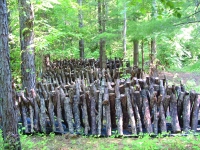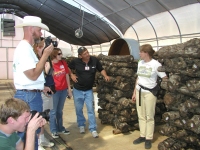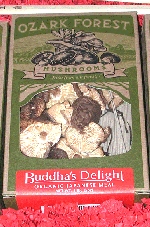Specialty Mushrooms in Agroforestry
Specialty and gourmet mushroom production is a promising component of the Center's forest farming research dimension. In fact, UMCA supports one of only two research programs in the nation working to develop the premium, high-dollar European black truffle as a forest farming crop for landowners, and is finding that this gourmet mushroom grows well in Missouri soil. Research is also being conducted to develop morel, shiitake and other gourmet mushrooms into profitable agroforestry crops in a forest farming practice.

|
Forest farming, one of the five agroforestry practices, can enhance and diversify farm income opportunities, while at the same time making significant improvements to the composition and structure of the forest for long-term improvements in overall health, quality and economic value. By developing an understanding of the interactions between the overstory trees and the understory environment, forest management activities can be used to create an understory capable of growing profitable shade-loving crops -- such as gourmet mushrooms.
Not only can specialty mushrooms be grown on a range of acreage allotments, mushroom cultivation is a sustainable and profitable way to recycle low-value forestry by-products, including non-merchantable stems and branch wood. Utilizing shade levels and understory from a forest farming practice, UMCA scientists and collaborators are determining the best suited types of mushrooms for Missouri soils. The goal of this research is to refine established production techniques for a diverse suite of outdoor mushroom species and enable Missouri landowners to capture a growing gourmet market
Specialty Mushroom Workshops

|
Through international collaborations and information exchanges, and programs close to home -- including a series of guidesheets and annual Specialty Mushroom Workshops -- the Center continues to accumulate a practical, scientifically-sound knowledge base for the benefit of Missouri landowners who are entering the specialty mushroom market. More than 40 participants from across the Midwest attended the February 2006 workshop, designed to teach the basics of production and/or marketing techniques for specialty gourmet mushrooms, including shiitake, oyster and Stropharia. University of Missouri research faculty members, professional mushroom growers and marketers provided participants the knowledge and skills needed to get started growing and marketing mushrooms. A hands-on tour of the mushroom cultivation sites at the MU Horticulture and Agroforestry Research Center, New Franklin, Mo., featured demonstrations of UMCA current research and explored the steps involved in growing mushrooms in a forest farming setting. Read more about the workshop.
Read about shiitake production in the Agroforestry in Action guide, "Growing Shiitake Mushrooms in an Agroforestry Practice."
Shiitake Mushroom Success Story

|
One of the state's most significant demonstrations of a successful forest farming practice is Dan Hellmuth and Nicola Macpherson's Ozark Forest Mushrooms, Timber, Mo. The entrepreneurial couple established the specialty mushroom operation in 1990 on what was then a timber operation, and coordinate every step of the value-added process, from the inoculated log to packaged, consumer-friendly products. Under the guidelines of the Stewardship Incentive Program, administered by the Missouri Department of Conservation (MDC), Hellmuth and Macpherson harvest a renewable supply of mushroom bed logs while simultaneously maintaining their forested acres in a healthy ecological state - and what began 14 years ago with only 100 oak logs in production has grown to include 12,000 shiitake logs in production.
A new greenhouse with a wood furnace for burning spent/culled shiitake logs has been completed for researching mushroom cultivation during the cold season and sustainable usage of wood resources. Packaged products marketed by Ozark Forest Mushrooms include dried and fresh shiitakes, oyster mushrooms, and seasoned mushroom meal mixes featuring Asian and Indian influences
It's hard work that doesn't stop," Macpherson said, "but when I walk into a restaurant and see my mushrooms on the menu, or walk into a supermarket and see our products on the shelf, that gives me huge pleasure and makes all the work worthwhile.
For more information, visit http://www.ozarkforest.com
Gourmet Mushroom Research:
Research Publications:
- Bruhn, J.N., Mihail, J.D., Wetteroff, J.J., Jr., and Clark, T.A. 2003. Evaluating management practices for log-grown shiitake production in midwestern agroforestry. In: Van Sambeek, J.W.; Dawson, J. O.; Ponder, F., Jr.; Loewenstein, E. F.; Fralish, J. S., eds. Proceedings, Thirteenth Central Hardwood Forest conference; 2002 April 1-3; Urbana, IL. Gen. Tech. Rep. NC-234. St. Paul, MN: U.S. Department of Agriculture, Forest Service, North Central Research Station. p. 88-100.
Project: Shiitake Cultivation In Midwestern Agroforestry
Project Team: Johann N. Bruhn, Jeanne D. Mihail, and James J. Wetteroff, Jr. Department of Plant Microbiology & Pathology, 108 Waters Hall, University of Missouri -- Columbia, and University of Missouri Center for Agroforestry.
ABSTRACT
Two outdoor shiitake (Lentinula edodes (Berk.) Pegler) cultivation
experiments were established at the MU Horticulture and Agroforestry Research
Center in central Missouri in December 1999 and May 2000. Fruiting began in
August 2000. We compared two models for analysis of treatment effects through
2003.
Background
- Values of woodland ownership can be enhanced through mushroom cultivation.
- Mushroom production is compatible with many other management objectives.
- Mushroom cultivation provides profitable means for recycling low-value forestry by-products.
- Though about two-thirds of central U.S. woodland mushroom growers have other income, nearly all consider mushroom cultivation part of their career, and nearly all grow shiitake (3).
- While a great deal of descriptive literature on log-based shiitake cultivation exists (e.g., 5-9), experimental studies relevant to the central U.S. are scarce (e.g., 1, 2, 10).
- A research and demonstration project has been initiated at the University of Missouri Center for Agroforestry (UMCA) to identify best management practices for woodland cultivation of specialty fungi, including shiitake (Fig. 1).
- We present results of two experiments which evaluate the effects of several management factors on natural (non-forced) fruiting.
Objectives
Specific research objectives of the two experiments presented here are to:
- compare shiitake strain productivity;
- compare the productivity of several readily available substrate tree species;
- compare the productivity of the most readily available forms of spawn;
- evaluate the productivity associated with early winter and spring inoculation;
- evaluate the relative productivity of immediate vs. delayed inoculation;
- compare analyses of biological efficiency (BE) with a new form of regression model that uses total mushroom weight (TW) produced by each log as the response variable while including variables characterizing each log as covariates.
For study results and information, email your request to: Rachel McCoy, UMCA Sr. Information Specialist, at mccoyr@missouri.edu
Additional Resources
Internet Resources:
Field & Forest Products. Growers' information, starter kits, spawn and products.
http://www.fieldforest.net/. (800) 792-6220.
Ohio State University Extension. Guides for production and marketing. Type "shiitake" under Search option. http://extension.osu.edu/
Ozark Forest Mushrooms. Commercial production of shiitakes and other gourmet mushrooms. Growing process information and examples of value-added products. http://www.ozarkforest.com. (314)531-9935.
Shiitake Mushroom Production: Introduction and Sources of Information and Supplies. http://ohioline.osu.edu/for-fact/0039.html.
University of Kentucky Cooperative Extension Service. In "Search" type "shiitake" for several production guides. http://ces.ca.uky.edu/ces/
Books:
The Mushroom Cultivator, by Paul Stamets and J.S. Chilton. Information on every
aspect of mushroom cultivation for several species.
Shiitake Growers Handbook, by Paul Przybylowicz and John Donoghue. Information on scientific material and basic advice on several aspects of shiitake cultivation.
Growing Shiitake Commercially, by Bob Harris. Focuses on commercial growing of shiitakes on oak logs.
Associations:
The North American Mycological Association: Includes a annual directory and bimonthly
newsletter. http://www.namyco.org
The Mushroom Council: Web site offers marketing and consumer trend information. http://www.mushroomcouncil.org
"The Mushroom Growers' Newsletter" is available at http://www.mushroomcompany.com.

